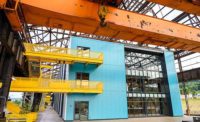A mobile robot built by engineers at Carnegie Mellon University (CMU) will reach the Moon before NASA astronauts. The four-wheeled device, dubbed Iris, features a carbon-fiber composite body about the size of a shoebox and wheels that are designed to survive the harsh lunar environment.
When it launches sometime this summer, Iris will become the first university-built lunar rover to leave Earth and the first lunar vehicle not made by a national space agency. It will also be the first American robot to drive on the Moon.
The lightweight vehicle will travel to outer space aboard a Vulcan Centaur rocket from United Launch Alliance. A Peregrine lunar lander produced by Astrobotic Technology will transport Iris to the Moon’s surface, where it will conduct a 60-hour mission that includes taking photos and sending them back to Earth as it rolls along.
Several hundred students worked on the project, which has turned out to be a unique exercise in concurrent engineering and team building. Along the way, they built a cleanroom to assemble the rover and a mission control center.
Iris only weighs about 4 pounds, but it’s built tough to survive intense vibrations and extreme temperatures. It features a novel wheel design that uses a four-wheel-drive skid-steer platform. The composite wheels, which resemble bottle caps, are ultralight and don’t require any suspension.
The heart of Iris is a flight computer and a power system that’s integrated with various cameras, sensors, motors and wire harnesses. Students also developed and programmed software that enables the battery-powered vehicle to map and plan operations, take images and analyze data. In addition, they developed software that simulates the lunar environment visually and mechanically, which enabled operators to train for the mission.
Students will control and monitor Iris from a mission control center set up on CMU’s campus. They’ll work in shifts to stay in constant contact with the rover and send it commands.
In addition to devoting hundreds of development hours to the project, the students have spent weeks conducting mission simulations, getting comfortable with the controls and working out what to do in any situation.
“Hundreds of students have poured thousands of hours into Iris,” says Raewyn Duvall, a Ph.D. student studying electrical and computer engineering, who’s also serving as commander of the Iris mission. “We’ve worked for years toward this mission.
“Iris will open up lunar and space exploration by proving that a tiny, lightweight rover built by students can succeed on the Moon,” explains Duvall. She says the Iris mission will tick many “first” boxes with its historic trip.
“It will be the first American lunar rover, the first student-developed rover, the smallest and lightest rover, and the first with both a carbon-fiber chassis and wheels,” claims Duvall. “The Iris mission demonstrates what is possible, and could chart the future of planetary exploration.”
Iris will be secured to the underside of one of Peregrine’s payload decks. To prepare for the voyage, it underwent a series of tests to ensure that it could fit in its allotted space, withstand the vibrations expected during launch, endure the vacuum of space and survive the cold temperatures expected on the Moon.
The engineers also tested its electronic emissions to ensure that they do not interfere with the lander or other payloads, such as the MoonArk. The intricate titanium, platinum and sapphire artifact contains hundreds of images, poems and music relating to arts, humanities, sciences and technologies.
MoonArk will be the first museum on the moon. The 10-ounce cylinder comprises four small chambers containing the work of more than 250 contributing artists, designers, educators, scientists, engineers, choreographers, poets, writers and musicians.
“[The Iris Rover project] is a testament to the more than 200 CMU students who worked on it over the span of three years,” says William “Red” Whittaker, Ph.D., a robotics professor and director of the Field Robotics Center at CMU. “The initiative is a pinnacle of human achievement as much as it is a masterwork of technical virtuosity.
“In space, what matters is what flies, and soon you’ll see irrefutable proof that what Carnegie Mellon has accomplished in planetary exploration matters a great deal,” adds Whittaker.
The CMU students have also built a larger rover called MoonRanger. The autonomous, solar-powered vehicle is scheduled to deploy sometime later this year to search for evidence of water on the lunar surface.











